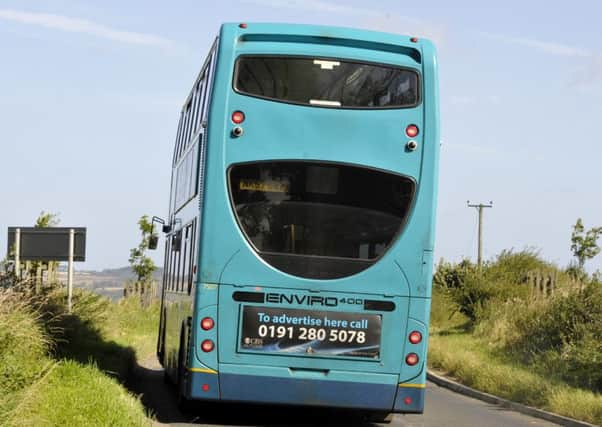Drastic decrease in bus miles in Northumberland


The number of miles clocked up each year by buses – the standard measure for the size of the bus network – across Britain has hit its lowest point in 28 years.
The decrease in the county represents a 19.6 per cent drop in the overall number of miles from 2013/14 to 2016/17.
Advertisement
Hide AdAdvertisement
Hide AdThis percentage drop sees it ranked 10th out of all the transport authorities in England in terms of the biggest decreases in the past four years.
Also concerning for a large, rural county like Northumberland is that while the number of commercial miles has increased by 0.47 million or seven per cent in that four-year period, the number of subsidised miles – where bus companies are given financial support by local authorities – has fallen by 38.5 per cent (-0.86 million), although this does not place the county among the hardest-hit.
The number of passenger journeys has dropped in Northumberland over the same period, from 10 million in 2013/14 to 8.6million in 2016/17.
In terms of journeys per head of population, this is a fall from 31.6 to 27.3, or 13.6 per cent – the 14th largest decrease in England.
Advertisement
Hide AdAdvertisement
Hide AdLooking at the figures for the North East as a whole, 19 million bus miles have been lost over the past decade, which represents a 18.8 per cent drop – the second highest of any English region after the North West.
Another four English regions have seen vehicle miles cut in the past decade.
In the past four years alone, the number of subsidised miles driven by buses in England (outside London) each year has reduced by 59 million (down 32 per cent).
Commercially-run miles have increased slightly in the last four years (up 0.4 per cent). However, there are big regional variations which suggest a north-south divide.
Advertisement
Hide AdAdvertisement
Hide AdCommercial bus companies have cut vehicle miles in the North West, Yorkshire and The Humber, the West Midlands and the North East, but increased them in the South West, East Midlands, South East and East of England.
Coun Martin Tett, the Local Government Association’s transport spokesman, said: “It’s nearly impossible for councils to keep providing subsidised travel while having to find billions of pounds worth of savings and protect other vital services like caring for the elderly, protecting children, filling potholes and collecting bins.
“Faced with significant funding pressures, many councils across the country are being forced into taking difficult decisions to scale back services and review subsidised routes.”
A spokeswoman for the Confederation of Passenger Transport (the trade body for bus operators) said: “Buses are the most used mode of public transport, with over 4.44 billion journeys undertaken each year. This represents five per cent of all trips and 59 per cent of public-transport trips.
Advertisement
Hide AdAdvertisement
Hide Ad“Private operators have invested many millions of pounds on new vehicles and the UK now has the youngest-ever bus fleet with an average vehicle age of less than eight years.
“The buses on the road today are the cleanest and most environmentally-friendly we have ever seen. And the UK has one of the most accessible bus networks anywhere in the world.”
She added: “In the vast majority of cases, cuts to bus services have occurred where local authorities have withdrawn financial support to non-commercial routes. Returning to a regulated market would put further intolerable strain on those budgets.
“Recent research into the demand for bus journeys shows that most of challenges arise from external factors facing the industry. No single organisation can tackle all the issues.
Advertisement
Hide AdAdvertisement
Hide Ad“It is unfair to say that operators are risk-averse. Where routes become unviable, sound business decisions need to be taken and there are many examples of operators continuing to operate lightly used and uneconomic services or developing innovative ways of meeting passengers’ needs.
“Through working together, operators and local authorities can make bus travel even more attractive to passengers, thereby helping to reduce congestion and improve local air quality, as well as providing a catalyst to unlocking further investment.”